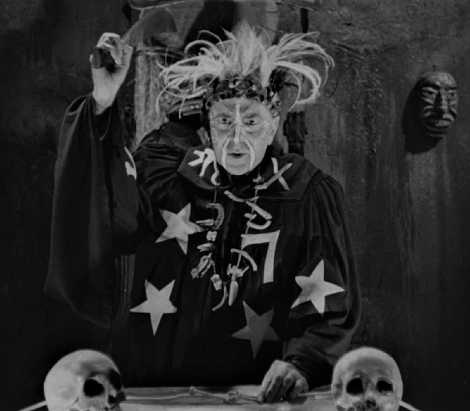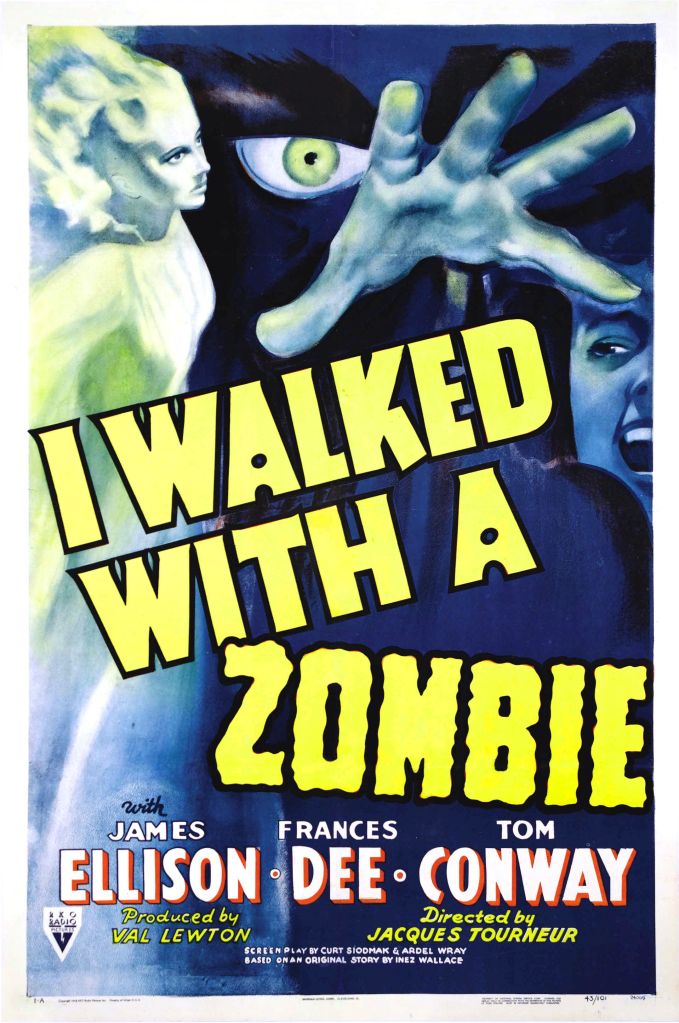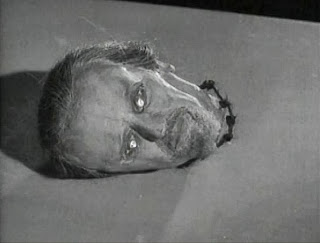From We Belong Dead, Issue 24, published 2021
Ask anyone to define “zombie” and you’ll probably get the same answer: A dead person, reanimated, hungry for human flesh. After more than 50 years of pop culture saturation, it’s hard to imagine another response. Such is the influence of George A. Romero’s 1968 masterpiece Night of the Living Dead.
Romero may have invented the ravenous ghoul archetype, but he preferred not to use the z-word in his movies. Before Night, it was used plenty of times, but in very different ways. These flexible definitions led to some creative – and often very weird – cinematic efforts.
They also make it hard to determine what qualifies as a zombie film. Supernatural forces are often involved, but sometimes it’s science run amok, or a combination of the two. Films set far from the Caribbean still use the region’s folklore and terminology. In the 1930s, Boris Karloff played resurrected dead men no fewer than seven times, in everything from The Mummy to The Man They Could Not Hang, but those characters are rarely labeled zombies. By the 1950s, even aliens were getting in on the act.
The first universally acknowledged zombie film is Victor Halperin’s White Zombie (1932), which set the template for decades of racial stereotypes, shady European interlopers, and catatonic women in flowing gowns. It cashed in on the success of William Seabrook’s 1929 book The Magic Island, which related the author’s encounters with Haiti’s voudoun religion and its tales of the reanimated dead. Seabrook’s mix of research and sensationalism fascinated American readers, and “voodoo” had become a popular subject by the time Victor and his producer brother, Edward, began filming.
White Zombie draws on Haiti’s tragic history, with wealthy outsiders turning workers and enemies into slaves. In this case, the villain is Murder Legendre, played by Bela Lugosi with his usual hammy charisma (or is it charismatic hamminess?). When a local plantation owner (Robert W. Frazer) falls in love with a young bride-to-be (Madge Bellamy), he hires Murder to put her under his spell. And you really shouldn’t trust a man with a name like that.
Despite the story’s roots, the local culture receives only cursory attention. The use of slave labor in Murder’s sugar cane mill is treated with disgust by the “respectable” characters, despite their reliance on it, but Murder’s abilities are most often used for personal ends. His zombie hit squad consists of people who have wronged him, the kind of powerful men who once benefited from his skills. He’s an oppressor who also feels oppressed, illustrated by his indignant response when Frazer refuses to shake his hand.

For a low-budget early sound film, White Zombie remains highly entertaining. Its limitations could even be seen as advantages, as choppy editing and abrupt sound effects lend a surreal quality that more polished productions would try to avoid. Plus, it has Lugosi at his peak. It was influential for good reason.
The Halperins followed up with the markedly inferior Revolt of the Zombies (1936). Set during World War I, it offers the first use of zombies as super-soldiers, who inexplicably hail from Cambodia. When the Allied commanders learn about this power, they send an expedition to Angkor to find and destroy the source before it leads to the “destruction of the white race.” The potentially interesting premise is squandered by another love triangle plot and the lack of any interesting performances (although Roy D’Arcy, as the main villain, does his best Murder Legendre impression). Lugosi’s hypnotic eyes from White Zombie appear on screen occasionally, only to remind viewers of what they’re missing.
George Terwilliger’s Ouanga took the action back to the Caribbean and mixed in plenty of mystery and controversy. Possibly completed in 1933 (but maybe ‘35 or ‘36), it was plagued by production disasters, and wasn’t released in the U.S. until 1941 (as The Love Wanga). Fredi Washington stars as Clelie, a light-skinned black plantation owner who falls in love with a white man. Naturally, he spurns her for a woman of his “own kind,” prompting Clelie to summon zombies in revenge. She is stopped by a black overseer, played by white actor Sheldon Leonard in blackface. It’s like a “Race in Cinema” film studies thesis come to life.
Ouanga’s miscegenation theme didn’t go over well with censors, and it’s become a very hard film to find, aside from clips on YouTube. It was remade (sort of) as The Devil’s Daughter in 1939, changing the love story to a family land dispute and removing any actual magic.
The major studios avoided the living dead, with rare exceptions. Paramount included a zombie guard stumbling around the 1940 Bob Hope comedy The Ghost Breakers (remade in 1953 as Scared Stiff, with even less zombie action). Universal made the zombie-adjacent The Mad Ghoul in 1943, with George Zucco using an ancient Mayan poison gas to control a romantic rival.

Otherwise, it was up to the low-budget outfits to keep the genre going, and none was more low-budget than Monogram Pictures. The “poverty row” studio released King of the Zombies in 1941, featuring a European doctor (Henry Victor) in the Caribbean using voodoo to extract information from a captured American admiral. The heroes are bland and the plot is nonsensical. The only interesting character is Jeff, a valet played by black comic actor Mantan Moreland, who somehow gets a few funny moments out of the horribly racist script. Everything else – including the sets, probably – is cardboard. Monogram simply hadn’t found its winning formula yet.
It needed charisma. It needed stars who would do anything for a paycheck. It needed John Carradine and Bela Lugosi.
And it got them. In Bowery at Midnight (1942), Lugosi runs a homeless shelter and teaches college-level psychology. The shelter is a front for criminal activity, which he covers up by murdering his accomplices. He also abuses his drug-addled assistant (Lew Kelly), whom he allows to resurrect corpses in a sub-basement. Bad idea on both counts (although one character seems to recover completely from the experience, without explanation).
Next came Revenge of the Zombies (1943), a quasi-sequel to King of the Zombies (Moreland and the improbably-named Madame Sul-Te-Wan both return). Carradine stars in this one, as a Nazi scientist in Louisiana trying to create undead soldiers. It’s the first explicit reference to the Third Reich, as the U.S. hadn’t entered World War II when King of the Zombies was released, and there seems to have been some reluctance to clarify who Victor’s “Austrian refugee” was working for. There are no such qualms here, and it makes for a singular piece of wartime propaganda.
Carradine also turns up in The Face of Marble (1946), which combines magic and pseudo-science to create ghost/zombie hybrids (including an undead dog). Per usual, the mechanics of this are not well thought out, but the sight of a Great Dane walking through walls is at least unique.

But it was in 1944 that Monogram truly found the perfect expression of its brand, pairing Carradine with Lugosi and Zucco for Voodoo Man.
Lugosi is the unhinged doctor this time, while Carradine plays a pervy, silly-walking servant who helps kidnap women for the doc’s experiments. Lugosi’s wife has been undead for 20 years, and he’s desperately trying to transfer a living victim’s life force into her. This involves some spectacularly campy rituals, with witch doctor Zucco donning an outfit that will live in bad-movie infamy. The best thing about most Monogram films is that they’re very short, but this one is actually fun.
The same cannot be said for RKO’s Zombies on Broadway, from the following year. It stars the comedy(?) team of Wally Brown and Alan Carney as press agents seeking real zombies for a nightclub act. Lugosi plays a mad scientist (naturally), a monkey annoys everyone, and Carney wears blackface for a while. But the most awful, offensive thing about this movie is that it’s an unfunny parody of the studio’s (and the decade’s) greatest zombie film, I Walked with a Zombie (1943).
Produced by Val Lewton and directed by Jacques Tourneur, I Walked with a Zombie was part of a remarkable run of intelligent, beautifully-shot horror films attached to the cheesy titles invented by RKO executives. This one may represent the greatest disconnect in the series, as Lewton and Tourneur tell an understated story about love, death, and the power of belief that just happens to involve voodoo rituals and the walking dead.

Frances Dee plays the Jane Eyre-inspired heroine, who is hired to care for a plantation owner’s wife on the fictional island of St. Sebastian. The patient can walk and obey simple commands, but she is otherwise unresponsive. Is her condition the result of a medical condition, or are the locals right in calling her a zombie? In true Lewton fashion, it’s never entirely clear. What is clear is Dee’s determination to get answers, even if it means leading her charge through the fields at night, toward a ceremony that could mean the difference between life and death. But the answers never really come, for the characters or the audience. The result is poetic and unsettling.
That RKO sullied this with Zombies on Broadway shows how little respect even the best genre films were getting by that time. It would be over a decade before traditional zombie fare made a comeback.

“Traditional” may be a misnomer, as the three 1957 releases are literally all over the map. Voodoo Island stars Boris Karloff as the leader of an expedition in the South Pacific, where the natives are turning greedy developers into zombies. The magical dolls they use are impressively strange, as are the killer plants that litter the island like escapees from Morticia Addams’ greenhouse. Womaneater goes even further, as British doctor Geoge Coulouris brings an enormous, gnarly-looking plant home from the Amazon, where he feeds young women to it to create a resurrection serum. The formula works once, for about two minutes, and it’s hilarious.
Zombies of Mora Tau takes place on the West African coast, where cursed sailors guard an ancient treasure at the bottom of the ocean. Naturally, fortune-seekers try to take the loot, and director Edward L. Cahn finds creative ways to show the undead attacking divers on a budget that did not allow for underwater photography. He also includes a scene of characters trapped in an enclosed space while zombies try to break in, a precursor to the siege scenarios that would define so many later efforts.
Cahn was also part of the 1950s’ most prolific low-budget genre, science fiction, which frequently featured reanimated corpses. In 1955, Cahn directed Creature with the Atom Brain, about a criminal who hires an (ex-Nazi?) scientist to revive and control a crew of undead hitmen. His 1959 film Invisible Invaders has aliens killing and inhabiting human bodies when Earth’s governments refuse to accept their invasion plans. The latter includes scenes of mass destruction that lend it an apocalyptic feel, already becoming popular in the age of nuclear weapons and Cold War paranoia.
Not that it’s any good, but Invisible Invaders is part of a continuum that includes the sublime highs of Invasion of the Body Snatchers (1956) and the absurd lows of Plan 9 From Outer Space (1958). In these films, the danger is coming from outer space, but it looks just like your friends and neighbors, albeit with pale makeup and murderous intent. None of them ends on an especially cheerful note, either. The better ones, like British efforts Quatermass 2 (1957) and The Earth Dies Screaming (1965), may allow humanity some small victories, but the existential threat never goes away.

As the genre moved into the ‘60s, there were a few straightforward voodoo-themed efforts, like The Dead One (1961) and I Eat Your Skin (1964 – and so bad, it wasn’t released until 1971). But filmmakers increasingly had to distinguish themselves in an oversaturated market, and they did so by any means necessary. Teenage Zombies (1959) has a mind-controlled gorilla and a glamorous scientist who wears evening gowns in the lab. The Cape Canaveral Monsters (1960) are aliens in the mangled bodies of car crash victims. One of them keeps losing his arm, to unintentionally comedic effect.
Nazis make a comeback in The Frozen Dead (1966), as Dana Andrews thaws out his old colleagues with disastrous results. Karloff heads to the South Pacific again in Isle of the Snake People (1968), thankfully not participating in the cannibalism and borderline necrophilia. The Last Man on Earth (1964) technically features virus-infected vampires clashing with Vincent Price, but the devastating end-of-the-world tone would be a huge influence on later zombie cinema.

In Mexico, masked wrestler El Santo took on the undead in some of his many adventures, most notably (and obviously) in Santo vs. the Zombies (1961). The Curse of the Doll People (1960) had a truly insane combination of black magic, Catholicism, zombie attacks, and little people in creepy masks playing killer voodoo dolls. Italy offered a sword-and-sandals take with War of the Zombies in 1964, in which the priest of an unspecified goddess brings Roman soldiers back from the dead to fight their own legions. It has sword fights, bad dubbing, and John Drew Barrymore (son of John, father of Drew) snacking on scenery, yet it’s still somehow as boring as anything Monogram cranked out in the ‘40s. And, of course, there’s the infamous The Incredibly Strange Creatures Who Stopped Living and Became Mixed-Up Zombies (1964), a “monster musical” whose title was given much more thought than its script.
The Gothic horror revival pioneered by Hammer Studios in the ‘50s inspired a subgenre of living-dead films set in old castles and crumbling ruins, including Dr. Orloff’s Monster (1964) and Terror-Creatures from the Grave (1965). One of the better entries is Doctor Blood’s Coffin (1960), in which the egomaniacal (and aptly-named) title character (Kieron Moore) conducts his experiments in an abandoned Cornish tin mine. It’s classy and gross in equal measure, and co-stars Hammer veteran Hazel Court.
In 1966, Hammer would set its own zombie tale in a similar location, creating the last true classic before Romero’s vision took over. The Plague of the Zombies is something of a throwback, dealing with a sleazy rich man (John Carson) who uses voodoo to exploit the poor. Instead of Murder Legendre, he has the more prosaic name of Clive Hamilton, squire of a village in Cornwall beset by mysterious deaths. Squire Hamilton can’t get anyone to work in his family’s dangerous tin mines, so he creates a zombie labor force with skills he picked up while traveling in Haiti (pronounced “High-ee-ti”). He also sets his sights on a couple of young women, including the daughter (Diane Clare) of Sir James Forbes (André Morrell), a man far too brave and grouchy to let this threat go unanswered.

Directed by John Gilling, The Plague of the Zombies has Hammer’s usual combination of elegance and excess. It’s smartly written and looks more expensive than it is, with some mid-’60s gore thrown in, including a beheading. The zombies are genuinely scary, especially in the infamous dream sequence, an early portrayal of corpses crawling from their graves en masse. But these blank-eyed ghouls aren’t nearly as scary as Squire Hamilton and his cruel, entitled friends. The greatest danger here is from the living, not the undead.
In just a couple of years, that idea would find new, visceral expression in an abandoned farmhouse outside Pittsburgh. There was no longer any need for voodoo priests or god-playing scientists. Now, ordinary people faced hordes of walking corpses, with no explanation, and no motive beyond survival on either side. Nothing – on screen or off – would ever be the same. – Loey Lockerby

Leave a comment